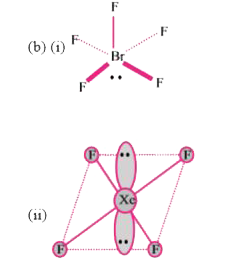(a) Account for the following:
(i) Ozone is thermodynamically unstable.
(ii) Solid PCl5 is ionic in nature.
(iii) Fluorine forms only one oxoacid HOF.
(b) Draw the structure of
(i) BrF5
(ii) XeF4
(i) Compare the oxidizing action of F2andCl2 by considering parameters such as bond dissociation enthalpy, electron gain enthalpy and hydration enthalpy.
(ii) Write the conditions to maximize the yield of H2SO4 by contact process.
(iii) Arrange the following in the increasing order of property mentioned :
(a) H3PO3,H3PO4,H3PO2 (Reducing character)
(b) NH3,PH3mAsH3,SbH3,BiH3 (Base strength)
(a) (i) Endothermic compound/decomposition of ozone is exothermic is nature and ΔG is negative/decomposition of ozone is spontaneous.
(ii) Exists as [PCl4]+[PCl6]+
(iii) Shows only-1 oxidation state/most electronegative element/ absence of d-orbitals
(b)(i) 
Or
(i) F2 is the stronger oxidising agent than chlorine
(a) low enthalpy of dissociation of F−F bond
(b) less negative electron gain enthalpy of F
high hydration enthalpyof F+ ion
(ii) Low temperature, high pressure and presence of catalyst
(ii) H3PO4<H3PO3<H3PO2
(iii) BiH3<SbH3<AsH3<PH3<NH3
Topper's Solved these Questions
- PRACTICE - PAPERBOOK - CBSE COMPLEMENTARY MATERIALCHAPTER - PRACTICE - PAPEREXERCISE - Section : C
6 Videos
- POLYMERS BOOK - CBSE COMPLEMENTARY MATERIALCHAPTER - POLYMERS EXERCISE - LONG ANSWER TYPE QUESTIONS
5 Videos
- PRACTICE PAPER 1BOOK - CBSE COMPLEMENTARY MATERIALCHAPTER - PRACTICE PAPER 1EXERCISE - Questions
82 Videos
Similar Questions
Considering the parameters such as bond dissociation enthalpy, electron gain enthalpy and hydration enthalpy, compare the oxidizing power of F2 and Cl2.
View SolutionConsidering the parameters such as bond dissociation enthalpy, electron gain enthalpy and hydration enthalpy, compare the oxidising power of F2andCl2.
View SolutionConsidering the parameters such as bond dissociation enthalpy, electron gain enthalpy and hydration enthalpy, compare the oxidising power of F2andCl2
View SolutionConsidering the parameters such as bond dissociation enthalpy, electron gain enthalpy and hydration enthalpy, compare the oxidising power of F2andCl2
View SolutionCompare the oxidizing powers of F2andCl2 on the basis of bond dissociation enthalpy, electron gain enthalpy of halogens and hydration enthalpy of halide ions.
View SolutionConsidering the parameters such as bond dissociation enthalphy, electron gain enthalpy and hydration entalpy, compare the oxidising power of F2 and Cl2.
View SolutionConsidering the parameters such as bond dissociation enthalpy, electron gain enthalpy and hydration enthalpy, compare the oxidising power of F2andCl2
View SolutionDraw the structures of (i)PCl5(s), (ii)SO2−3
View SolutionAccount for the following: Fluorine forms only one oxoacid HOF.
View SolutionWrite the structure of the following :
(i) BrF3 (ii) XeF4
View Solution
